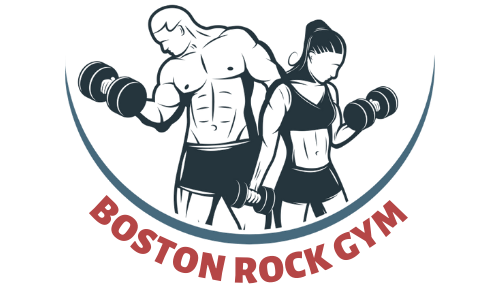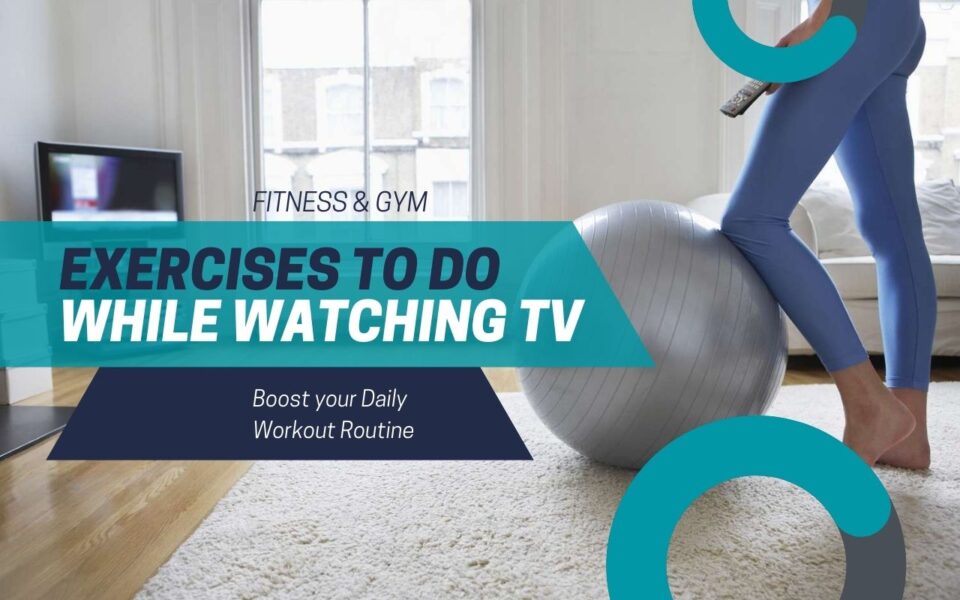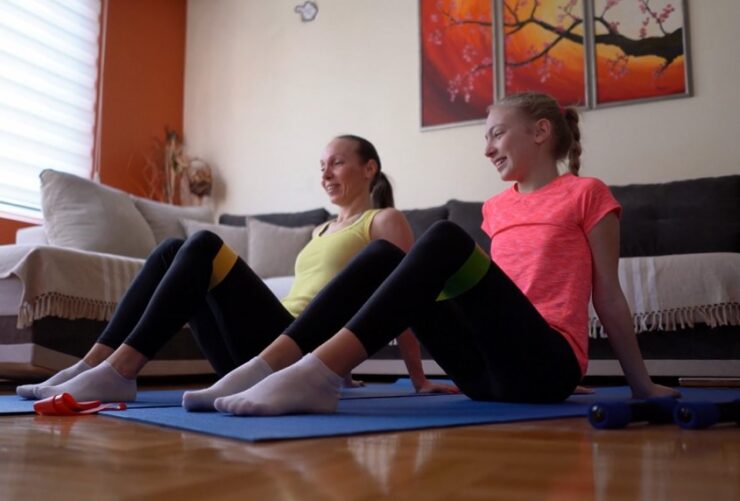Are you always in a time crunch and don’t have time to hit the gym? Or is it just easier and more convenient for you to work out from the comfort of your own home?
Whatever the case may be, you can totally use our guide to exercise from your living room with the same results as if you were in the gym!
Exercising is important for various reasons, including your overall health. If you want to be healthy and fit, watching your diet isn’t the only thing you should pay attention to. You should also make sure that your daily routine includes a few exercises that will get you moving and get your blood flowing.
Luckily, you don’t have to spend an eternity trying to figure out what exercises you could do from your home—we’re here to help!
Using our guide, you’ll learn about 8 exercises that you can do while watching TV with minimum effort and in record time! Take a look below to find out all there is to know about these exercises.
Contents
Top 8 Exercises You Can Do Easily While While Watching TV
1. Sit-Ups
Sit-ups are basic abdominal workouts done by lying on your back and elevating your torso. They build and tone the core-stabilizing abdominal muscles by using your body weight. You can do sit-ups to work your hip flexors, chest, and neck in addition to the rectus abdominis, transverse abdominis, and obliques.
Strengthening your gluteal muscles and lower back will help you maintain proper posture. Sit-ups engage more muscles than crunches and static core workouts since they have a wider range of motion. They are the perfect addition to your exercise regimen because of this. Here’s how to do sit-ups:
• On a mat, lie on your back with your knees bent and your feet flat on the ground
• Cross your arms in front of your chest
• Contract your ab muscles In order to raise your shoulders off the mat
• Hold for a little moment, then gradually return to the starting position
2. Push-Ups
The push-up increases both upper-body and core strength. It may be done in a variety of ways—beginners can start with the simpler variations, while more experienced exercisers can employ the more difficult ones.
The push-up can be done as a bodyweight exercise, a circuit training exercise, or a strength exercise. Push-ups don’t directly burn fat, but resistance exercise does burn calories, which can aid in generating the necessary caloric deficit for weight reduction. You may also speed up your metabolism by adding muscle.
Take a look below to see how to do push-ups properly:
• Get down on all fours and put your hands slightly wider than your shoulders
• Avoid locking out your elbows and maintain a small bend in them
• Set your feet hip-width apart and extend your legs back until you are upright and balanced
• Pull your belly button toward your spine to tighten your core and contract your abs
• Take a deep breath and slowly drop yourself to the ground, bending your elbows to a 90-degree angle
• Exhale, then raise your hands and body back to the beginning position by contracting your chest muscles
3. Jumping Jacks
Jumping jacks are a convenient total-body exercise that can be performed practically anywhere.
Plyometrics, or jump training, is what this workout falls under. Resistance training and cardiovascular exercise are combined in plyometrics. Your heart, lungs, and muscles are all worked out simultaneously during this kind of exercise.
Your glutes, quadriceps, and hip flexors are specifically worked out by jumping jacks. Your shoulder and abdominal muscles are also involved during jumping jacks.
To perform jumping jacks, follow the next steps:
• Start by standing straight-legged with your arms at your sides
• Jump up, place your feet farther apart than hip-width apart, and lift your arms almost in touch
• Jump again while bringing your legs closer together and lowering your arms
• Get back to where you were
4. Planking
There are several physical advantages to planking. The core should be strengthened as part of any exercise program. A healthy and solid core both feels and looks good.
But more importantly, it supports the body’s ability to maintain balance and power throughout virtually all other activities. The foundation for all fluid and powerful athletic motions is core strength. A solid core helps ease the joint strain and helps you adopt a better posture.
This is how you do a plank:
• Start off face down in a plank posture with your forearms and toes on the ground. Point your forearms forward, and your elbows precisely beneath your shoulders. Your head should be relaxed, and you should be facing the ground
• By tightening your abdominal muscles, bring your navel toward your spine. Your body should remain firm and straight from your ears to your toes, without drooping or bowing
• Ensure that your shoulders are not tense and are not rising toward your ears. Your heels should be over your feet’s balls
• For ten seconds, maintain this posture, then drop to the ground
• Work your way up to 30, 45, or 60 seconds over time
5. Plank Twists
This workout targets your obliques and abs. Your shoulders, glutes, and quads will all benefit from the plank twist exercise. After crunches or another upper- and lower-ab workout, perform this one.
The guide below tells you how:
• Start in a plank posture with your elbows on the mat, your stomach lifted off the floor, and your toes pointed. Maintain a straight back
• Twist your left hip till it just touches the mat while keeping your belly button pressed in, then return to the plank posture
• Once your right hip is just touching the mat, swivel around and get back into the plank position. Thus, one rep is finished
6. Squats
Squats are a useful workout that improves your posture, joint, and muscle health, all of which are crucial for enhancing your running form and speed.
The quadriceps, glutes, hamstrings, and core are among the muscles that the squat also happens to help you develop for a strong and powerful stride. So it makes sense to include this exercise in your workout plan to help you balance your training.
The steps to performing squats are listed below:
• Stand with your feet slightly wider than hip-width and your toes pointed forward
• Push your knees slightly open and drive your hips back while bending at the knees and ankles
• Maintaining your heels and toes on the floor, sit into a squat position while maintaining your chest up and shoulders back
• Eventually, you want to get to parallel, which is when the knees are at a 90-degree angle
• To go back to a standing upright position, press your heels into the ground and straighten your legs
7. Lunges
You can shape and strengthen practically every muscle in the lower body with the help of the effective exercise known as lunges. Numerous lower body muscles might be strengthened and toned using this exercise.
The quadriceps, hamstrings, glutes, and calves are included in this. The lunge stretches the muscles in your hip flexors. This increases their flexibility and prevents the shortening and stiffness that might take place as a result of prolonged sitting.
Here’s how to do lunges properly:
• With the right foot around two to three feet in front of the left foot, adopt a split stance. Your core should be tight, shoulders back and down, and your hands should be resting on your hips
• When your back knee is only a few inches above the floor, bend your knees and squat down. Your weight should be evenly distributed between both legs at the bottom of the movement when the front thigh is parallel to the ground and the rear knee is pointing down
• Your weight should remain on the front foot’s heel as you raise yourself back up to the starting position
8. Step-Ups
This weighted step-up exercise is great for developing quadriceps strength. Step-ups, when done correctly, exert the least amount of stress on the knee because the quad development helps protect it.
Here’s how you can do step-ups easily:
• Place a step, box, or bench in front of you as you stand. Dumbbells should be held at shoulder height in your hands
• As you rise, straighten your right leg by pressing with your right foot’s heel
• Bring your left foot up to meet your right foot at the top of the step
• Step back with your left foot and bend your right knee
• Bring the right foot up to meet the left foot’s level
Conclusion
Exercising doesn’t have to be difficult or present an inconvenience! You can always choose to work out in a way that makes the most sense to you and is the most practical to you.
So, if you don’t want to hit the gym—don’t! Use our guide to exercise from the comfort of your own home like a pro! Work smarter, not harder, and start enjoying your workouts to the fullest!


